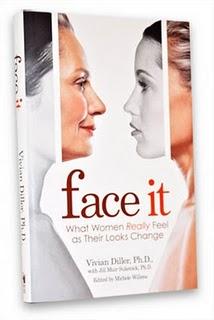Face It: What Women Really Feel as Their Looks Change

As the authors of Face It explain in the preface to their book, women who came of age during and after feminism's second wave were brought up to believe our looks don’t have to define who we are or determine our possibilities. What mattered more in this 'enlightened' new age were our brains, our talents, our degrees, our abilities, and our ambition. The paradox is that women continue to receive conflicting messages from the media and our culture about the role appearance plays in our lives. Because many of us have never attempted to unravel our ambivalent feelings about our appearance, the way it impacts our self-esteem, and how we relate to our family and friends, we deny these feelings when we see the first signs of aging—or react with a vengeance to try to arrest the aging process.
Face It is all about guiding women through this potentially treacherous time, during which many of us feel the very ground shifting beneath us. Like many adolescent girls, aging women cling to what the authors describe as “masks” that take the form of "workaholism," addiction to cosmetic surgery, excessive exercise, and dieting to protect ourselves from the sadness and loss we feel at the change in our appearance. In this thoughtful and engaging book, the authors, both psychotherapists and former models, present the stories of how different women approached the aging process. Runway models, nurses, homemakers, and businesswomen, who range in age from early thirties to mid-sixties, tell us their stories.
Some women never felt their appearance played much of a role in their lives, and were taken by surprise when they felt a sense of loss, or even panic, about their changing looks. In contrast, the models interviewed for the book were aware of aging, given that it pushes them out of their profession at the youthful age of twenty-five, and experienced a range of feelings and emotions similar to what many women face when they enter midlife. For women who believed that their intelligence and ambition were their ticket to success, it was often embarrassing to admit to friends and family how their changing looks were impacting them, because it seemed frivolous or superficial.
The authors use the experiences of these different women successfully navigating this challenging time with the use of an innovative six-step program that forms a pathway to a new acceptance and understanding of the aging process. This program involves taking an honest inventory of one's experiences with beauty and acknowledging how family and culture shapes one's identity as a woman. While the authors stress that they aren’t against using plastic surgery to enhance one's appearance, they want to give women the tools to make decisions about it from a place of strength and appreciation for their unique attributes, not out of a panic to "stay in the game."
As a forty-something woman, I found this book intriguing and was pleased to discover that it lived up to its billing of helping women navigate such a challenging time in our lives. Face It helps women of any age to gain an understanding of how to fully own the aging process and not react out of fear to our changing looks and bodies, but to, instead, appreciate and learn from the journey.